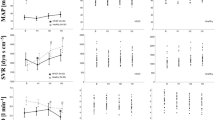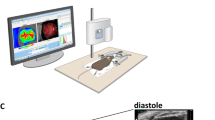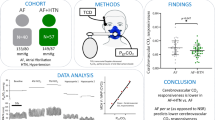Abstract
Syncope is caused by insufficient oxygen supply to the brain. There have been attempts to classify syncope on the basis of defects in the venous system, arterial system (that is impaired systemic vascular resistance) or a combination of the two (that is mixed). We examined the hypothesis that a comparable decrease in cerebral perfusion would be evident at pre-syncope irrespective of the category of dysfunction. Young healthy volunteers (N=37) participated. The protocol consisted of 15 min supine rest, followed by 60° head-up tilt and lower body suction in increments of −10 mm Hg for 5 min each until pre-syncope. Beat-to-beat blood pressure (BP) (Finometer or intra-arterial), cardiac output (Finometer), middle cerebral artery blood velocity (MCAv), end-tidal CO2 and cerebral oxygenation were monitored continuously. At pre-syncope, mixed dysfunction was common (21 out of 37 participants), followed by venular dysfunction (15 out of 37 participants). In the venular and mixed groups, comparable orthostatic tolerance and declines in BP (−37 vs −43% from baseline, respectively), end-tidal PCO2, MCAv (−35 vs −38%) and cerebral oxygenation (−5 vs −7%) were evident despite distinct mechanisms purportedly being responsible for the hypotension. Although different determinants of hypotension do exist, cerebral hypoperfusion occurs to a similar extent.
This is a preview of subscription content, access via your institution
Access options
Subscribe to this journal
Receive 12 digital issues and online access to articles
$119.00 per year
only $9.92 per issue
Buy this article
- Purchase on Springer Link
- Instant access to full article PDF
Prices may be subject to local taxes which are calculated during checkout



Similar content being viewed by others
References
Consensus statement on the definition of orthostatic hypotension pure autonomic failure multiple system atrophy. The Consensus Committee of the American Autonomic Society and the American Academy of Neurology. Neurology 1996; 46 (5): 1470.
Thijs RD, Wieling W, Kaufmann H, van Dijk G . Defining and classifying syncope. Clin Auton Res 2004; 14 (Suppl 1): 4–8.
Van Lieshout JJ, Wieling W, Karemaker JM, Secher NH . Syncope, cerebral perfusion, and oxygenation. J Appl Physiol 2003; 94 (3): 833–848.
Franco Folino A . Cerebral autoregulation and syncope. Prog Cardiovasc Dis 2007; 50 (1): 49–80.
Romme JJ, van Dijk N, Boer KR, Dekker LR, Stam J, Reitsma JB et al. Influence of age and gender on the occurrence and presentation of reflex syncope. Clin Auton Res 2008; 18 (3): 127–133.
Fuca G, Dinelli M, Suzzani P, Scarfo S, Tassinari F, Alboni P . The venous system is the main determinant of hypotension in patients with vasovagal syncope. Europace 2006; 8 (10): 839–845.
Thomson HL, Atherton JJ, Khafagi FA, Frenneaux MP . Failure of reflex venoconstriction during exercise in patients with vasovagal syncope. Clin Med 1996; 93: 953–959.
Hargreaves A, Muir A . Lack of variation in venous tone potentiates vasovagal syncope. Br Heart J 1992; 67: 486–490.
Sneddon JF, Counihan PJ, Bashir Y, Haywood GA, Ward DE, Camm AJ . Impaired immediate vasoconstrictor responses in patients with recurrent neurally mediated syncope. Am J Cardiol 1993; 71: 72–76.
Shen WK, Low PA, Rea RF, Lohse CM, Hodge DO, Hammill SC . Distinct hemodynamic profiles in patients with vasovagal syncope: a heterogeneous population. J Am Coll Cardiol 2000; 35 (6): 1470–1477.
Verheyden B LJ, van Dijk N, Westerhof BE, Reybrouck T, Aubert AE, Wieling W . Steep fall in cardiac output is main determinant of hypotension during drug-free and nitroglycerine-induced orthostatic vasovagal syncope. Heart Rhythm 2008; 5 (12): 1695–1701.
Barcroft HEO, Edholm OG, McMichael J . Posthaemorrhagic fainting study by cardiac output and forearm flow. Lancet 1944; 1: 489–491.
Lewis T . Vasovagal syncope and the carotid sinus mechanism. Br Med J 1932; 12: 873–874.
Deegan BM, O’Connor M, Donnelly T, Carew S, Costelloe A, Sheehy T et al. Orthostatic hypotension: a new classification system. Europace 2007; 9 (10): 937–941.
Fuca G, Dinelli M, Gianfranchi L, Bressan S, Lamborghini C, Alboni P . Do subjects with vasovagal syncope have subtle haemodynamic alterations during orthostatic stress? Europace 2008; 10 (6): 751–759.
Ramirez-Marrero FA, Charkoudian N, Hart EC, Schroeder DR, Zhong L, Eisenach JH et al. Cardiovascular dynamics in healthy subjects with differing heart rate responses to tilt. J Appl Physiol 2008; 105 (5): 1448–1453.
Norcliffe-Kaufmann LJ, Kaufmann H, Hainsworth R . Enhanced vascular responses to hypocapnia in neurally mediated syncope. Ann Neurol 2008; 63 (3): 288–294.
Porta C, Casucci G, Castoldi S, Rinaldi A, Bernardi L . The influence of respiratory instability during neurocardiogenic presyncope on cerebro- and cardiovascular dynamics. Heart 2008; 94 (11): 1433–1439.
Smit AA, Halliwill JR, Low PA, Wieling W . Pathophysiological basis of orthostatic hypotension in autonomic failure. J Physiol (Lond) 1999; 519 (Pt 1): 1–10.
Rowell LB . Control of regional blood flow during dynamic exercise, In Human Cardiovascular Control Oxford University Press: New York, 1993, pp 204–254.
Meendering JR, Torgrimson BN, Houghton BL, Halliwill JR, Minson CT . Menstrual cycle and sex affect hemodynamic responses to combined orthostatic and heat stress. Am J Physiol Heart Circ Physiol 2005; 289 (2): H631–H642.
Claydon VE, Younis NR, Hainsworth R . Phase of the menstrual cycle does not affect orthostatic tolerance in healthy women. Clin Auton Res 2006; 16 (2): 98–104.
Nollert G, Mohnle P, Tassani-Prell P, Reichart B . Determinants of cerebral oxygenation during cardiac surgery. Clin Med 1995; 92 (9 Suppl): II327–II333.
Murrell C, Wilson L, Cotter JD, Lucas S, Ogoh S, George K et al. Alterations in autonomic function and cerebral hemodynamics to orthostatic challenge following a mountain marathon. J Appl Physiol 2007; 103 (1): 88–96.
Lucas SJ, Cotter JD, Murrell C, Wilson L, Anson JG, Gaze D et al. Mechanisms of orthostatic intolerance following very prolonged exercise. J Appl Physiol 2008; 105 (1): 213–225.
LeLorier P, Klein GJ, Krahn A, Yee R, Skanes A, Shoemaker JK . Combined head-up tilt and lower body negative pressure as an experimental model of orthostatic syncope. J Cardiovasc Electrophysiol 2003; 14 (9): 920–924.
Atkinson G, Nevill AM . Statistical methods for assessing measurement error (reliability) in variables relevant to sports medicine. Sports Med 1998; 26 (4): 217–238.
Levine BD, Giller CA, Lane LD, Buckey JC, Blomqvist CG . Cerebral versus systemic hemodynamics during graded orthostatic stress in humans. Clin Med 1994; 90 (1): 298–306.
Magyar MT, Valikovics A, Czuriga I, Csiba L . Changes of cerebral hemodynamics in hypertensives during physical exercise. J Neuroimaging 2005; 15 (1): 64–69.
Claydon VE, Hainsworth R . Cerebral autoregulation during orthostatic stress in healthy controls and in patients with posturally related syncope. Clin Auton Res 2003; 13 (5): 321–329.
Hainsworth R . Pathophysiology of syncope. Clin Auton Res 2004; 14 (Suppl 1): 18–24.
Colman N, Nahm K, van Dijk JG, Reitsma JB, Wieling W, Kaufmann H . Diagnostic value of history taking in reflex syncope. Clin Auton Res 2004; 14 (Suppl 1): 37–44.
Lagi A, Cencetti S, Corsoni V, Georgiadis D, Bacalli S . Cerebral vasoconstriction in vasovagal syncope: any link with symptoms? A transcranial Doppler study. Clin Med 2001; 104 (22): 2694–2698.
Novak V, Spies JM, Novak P, McPhee BR, Rummans TA, Low PA . Hypocapnia and cerebral hypoperfusion in orthostatic intolerance. Stroke 1998; 29 (9): 1876–1881.
Peebles K, Celi L, McGrattan K, Murrell C, Thomas K, Ainslie PN . Human cerebrovascular and ventilatory CO2 reactivity to end-tidal, arterial and internal jugular vein PCO2. J Physiol (Lond) 2007; 584 (Pt 1): 347–357.
van Lieshout JJ, Pott F, Madsen PL, van Goudoever J, Secher NH . Muscle tensing during standing: effects on cerebral tissue oxygenation and cerebral artery blood velocity. Stroke 2001; 32 (7): 1546–1551.
Ide K, Pott F, Van Lieshout JJ, Secher NH . Middle cerebral artery blood velocity depends on cardiac output during exercise with a large muscle mass. Acta Physiol Scand 1998; 162 (1): 13–20.
Ogoh S, Brothers RM, Barnes Q, Eubank WL, Hawkins MN, Purkayastha S et al. The effect of changes in cardiac output on middle cerebral artery mean blood velocity at rest and during exercise. J Physiol (Lond) 2005; 569 (Pt 2): 697–704.
Secher NH, Seifert T, Van Lieshout JJ . Cerebral blood flow and metabolism during exercise: implications for fatigue. J Appl Physiol 2008; 104 (1): 306–314.
Bogert LW, van Lieshout JJ . Non-invasive pulsatile arterial pressure and stroke volume changes from the human finger. Exp Physiol 2005; 90 (4): 437–446.
Sugawara J, Tanabe T, Miyachi M, Yamamoto K, Takahashi K, Iemitsu M et al. Non-invasive assessment of cardiac output during exercise in healthy young humans: comparison between Modelflow method and Doppler echocardiography method. Acta Physiol Scand 2003; 179 (4): 361–366.
Jansen JR, Schreuder JJ, Mulier JP, Smith NT, Settels JJ, Wesseling KH . A comparison of cardiac output derived from the arterial pressure wave against thermodilution in cardiac surgery patients. Br J Anaesth 2001; 87 (2): 212–222.
Jellema WT, Wesseling KH, Groeneveld AB, Stoutenbeek CP, Thijs LG, van Lieshout JJ . Continuous cardiac output in septic shock by simulating a model of the aortic input impedance: a comparison with bolus injection thermodilution. Anesthesiology 1999; 90 (5): 1317–1328.
Harms MP, Wesseling KH, Pott F, Jenstrup M, Van Goudoever J, Secher NH et al. Continuous stroke volume monitoring by modelling flow from non-invasive measurement of arterial pressure in humans under orthostatic stress. Clin Sci (Colch) 1999; 97 (3): 291–301.
Kirkham FJ, Padayachee TS, Parsons S, Seargeant LS, House FR, Gosling RG . Transcranial measurement of blood velocities in the basal cerebral arteries using pulsed Doppler ultrasound: velocity as an index of flow. Ultrasound Med Biol 1986; 12 (1): 15–21.
Giller CA, Bowman G, Dyer H, Mootz L, Krippner W . Cerebral arterial diameters during changes in blood pressure and carbon dioxide during craniotomy. Neurosurgery 1993; 32 (5): 737–741.
Valdueza JM, Balzer JO, Villringer A, Vogl TJ, Kutter R, Einhaupl KM . Changes in blood flow velocity and diameter of the middle cerebral artery during hyperventilation: assessment with MR and transcranial Doppler sonography. Am J Neuroradiol 1997; 18 (10): 1929–1934.
Serrador JM, Picot PA, Rutt BK, Shoemaker JK, Bondar RL . MRI measures of middle cerebral artery diameter in conscious humans during simulated orthostasis. Stroke 2000; 31 (7): 1672–1678.
Strangman G, Culver JP, Thompson JH, Boas DA . A quantitative comparison of simultaneous BOLD fMRI and NIRS recordings during functional brain activation. Neuroimage 2002; 17 (2): 719–731.
Serrador JM, Hughson RL, Kowalchuk JM, Bondar RL, Gelb AW . Cerebral blood flow during orthostasis: role of arterial CO2. Am J Physiol Regul Integr Comp Physiol 2006; 290 (4): R1087–R1093.
Immink RV, Secher NH, Roos CM, Pott F, Madsen PL, van Lieshout JJ . The postural reduction in middle cerebral artery blood velocity is not explained by PaCO2 Eur. J Appl Physiol 2006; 96 (5): 609–614.
Acknowledgements
Funding from the Department of Physiology.
Author information
Authors and Affiliations
Corresponding author
Ethics declarations
Competing interests
The authors declare no conflict of interest.
Rights and permissions
About this article
Cite this article
Thomas, K., Galvin, S., Williams, M. et al. Identical pattern of cerebral hypoperfusion during different types of syncope. J Hum Hypertens 24, 458–466 (2010). https://doi.org/10.1038/jhh.2009.93
Received:
Revised:
Accepted:
Published:
Issue Date:
DOI: https://doi.org/10.1038/jhh.2009.93
Keywords
This article is cited by
-
Transcranial Doppler in autonomic testing: standards and clinical applications
Clinical Autonomic Research (2018)
-
Cerebral blood flow during HUTT in young patients with orthostatic intolerance
Clinical Autonomic Research (2015)
-
Autonomic cardiovascular response to acute hypoxia and passive head-up tilting in humans
European Journal of Applied Physiology (2013)



